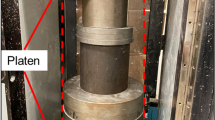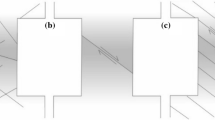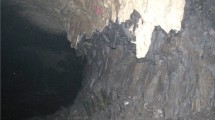Abstract
Many abandoned room and pillar mines have been excavated not far from the surface of large areas of important European cities. In Rome, these excavations took place at shallow depths (3–15 m below the ground surface) in weak pyroclastic soft rocks. Many of these cavities have collapsed; others appear to be in a stable condition, although an appreciable percentage of their structural components (pillars, roofs, etc.) have shown increasing signs of distress from both the morphological and mechanical points of view. In this study, the stress–strain behaviour of soft rock pillars sustaining systems of cavities under vertical loads was numerically simulated, starting from the in situ initial conditions due to excavation of the cavities. The mechanical behaviour of the constituent material of the pillar was modelled according to the Modified Cam-Clay constitutive law (elasto-plastic with strain hardening). The influence of the pillar geometry (cross-section area, shape, and height) and mechanical parameters of the soft rock on the ultimate compressive strength of the pillar as a whole was parametrically investigated first. Based on the numerical results, an original relationship for pillar strength assessment was developed. Finally, the estimated pillar strengths according to the proposed formula and well-known formulations in the literature were compared.











Similar content being viewed by others
Abbreviations
- \(\chi \) :
-
Pillar safety factor
- \(\sigma _{\mathrm{r}}\) :
-
Pillar compressive strength
- \(\sigma _{\mathrm{p}}\) :
-
Average pillar stress
- \(\sigma _{\mathrm{p}}^\gamma \) :
-
Average pillar stress contribution due to the weight of coating soils
- \(\sigma _{\mathrm{p}}^{\mathrm{y}}\) :
-
Pillar yield stress on the (\(\sigma _{\mathrm{p}},\varepsilon _{\mathrm{p}}\)) curve
- \(\varepsilon _{\mathrm{p}}\) :
-
Average pillar strain
- \(\varepsilon _{\mathrm{p}}^{\mathrm{y}}\) :
-
Average pillar strain at yielding
- \(\delta v_{\mathrm{gs}}\) :
-
Imposed vertical ground surface displacements
- \(A\) :
-
Pillar cross-section area
- \(b\) :
-
Small side of pillar cross-section
- \(l\) :
-
Large side of pillar cross-section
- \(d\) :
-
Pillar diameter
- \(h\) :
-
Pillar height
- \(b_{\mathrm{eq}}\) :
-
Side of equivalent square section pillar
- \({b}/{h}\) :
-
Pillar width-to-height ratio
- \({b_{\mathrm{eq}}}/{h}\) :
-
Pillar average width-to-height ratio
- \(\sigma _1\) :
-
Material uniaxial compressive strength
- \(\sigma _{\mathrm{u}}\) :
-
Unconfined compressive strength of a cubical pillar specimen
- \(k_{\mathrm{lp}}\) :
-
Pillar shape term (Lunder and Pakalnis’s formulation)
- \(c_{\mathrm{pav}}\) :
-
Pillar average confinement (Lunder and Pakalnis’s formulation)
- \(p\) :
-
Equivalent pressure
- \(q\) :
-
Deviator stress
- \(f(p,q)\) :
-
Yield function
- \(g(p,q)\) :
-
Plastic potential
- \({\varepsilon }^{pl({\mathrm el})}_{ij}\) :
-
Plastic (elastic) strain tensor
- \(\varepsilon ^{pl}_{\mathrm{mag}}\) :
-
Plastic strain magnitude
- \(\varepsilon _{p}^{\mathrm{pl(el)}}\) :
-
Plastic (elastic) volumetric strain
- \(\varepsilon _{q}^{\mathrm{pl(el)}}\) :
-
Plastic (elastic) deviator strain
- \(p_{\mathrm{c}}^*\) :
-
Current size of the yield surface
- \(J^{\mathrm{pl}}\) :
-
Plastic volume change
- \(p_{\mathrm{c}}\) :
-
Preconsolidation pressure
- \(M\) :
-
Slope of the critical state line on the (\(p,q\))-plane
- \(\lambda \) :
-
Logarithmic hardening constant in pure compression
- \(k\) :
-
Logarithmic bulk modulus in pure compression
- \(E\) :
-
Young’s modulus
- \(\phi \) :
-
Shear angle
- \(c\) :
-
Cohesion
- \(\nu \) :
-
Poisson’s ratio
- \(G\) :
-
Elastic shear modulus
- \(e\) :
-
Void ratio
- \(V\) :
-
Specific volume
References
Airey D (1993) Triaxial testing of naturally cemented carbonate soil. J Geotech Eng 119:1379–1398
Aversa S, Evangelista A (1998) The mechanical behaviour of a pyroclastic rock: yield strength and “destructuration effects”. Rock Mech Rock Eng 31(1):25–42
Bieniawski Z (1984) Rock mechanics design in mining and tunneling. AA Balkema, Rotterdam
Brady B, Brown E (2004) Rock mechanics, for underground mining. Kluwer Academic Publishers, Dordrecht
Cecconi M (1999) Structural characteristics and mechanical properties of a pyroclastic rock. PhD thesis, Dept. of Civil Engineering, University of Rome Tor Vergata (in italian)
Cecconi M, De Simone A, Tamagnini C, Viggiani G (2002) A constitutive model for granular materials with grain crushing and its application to a pyroclastic soil. Int J Numer Anal Methods Geomech 26(15):1531–1560
Coop M, Atkinson J (1993) The mechanics of cemented carbonate sands. Geotechnique 43(1):53–67
DeSimone A, Tamagnini C (2005) Stress–dilatancy based modelling of granular materials and extensions to soils with crushable grains. Int J Numer Anal Methods Geomech 29(1):73–101
Elliott G, Brown E (1985) Yield of a soft, high porosity rock. Geotechnique 35(4):413–423
Federico F, Screpanti S (2002) Stability analysis of cavities excavated in roman pyroclastic rocks. In: XXI Convegno Nazionale di Geotecnica Opere geotecniche in ambiente urbano, L’aquila (in italian)
Federico F, Screpanti S (2003a) Analytical criteria and numerical procedures for safety analyses of pillars and vaults excavated in pyroclastic rocks. In: XXII Convegno Nazionale di Geotecnica, Palermo (in italian)
Federico F, Screpanti S (2003b) Effects of filling shallow room and pillar mines in weak pyroclastic rock. In: XIIIth European conference on soil mechanics and geotechnical engineering: geotechnical problems with man-made and man influenced grounds
Federico F, Screpanti S, Rastiello G (2010) Stress–strain behaviour of a soft-rock pillar acted upon vertical loads. In: Benz T, Nordal S (eds) NUMGE 2010-European conference on numerical methods in geotechnical engineering. CRC Press, Boca Raton
González-Nicieza C, Álvarez-Fernández M, Menéndez-Díaz A, Álvarez-Vigil A (2006) A comparative analysis of pillar design methods and its application to marble mines. Rock Mech Rock Eng 39(5):421–444
Griffiths D, Fenton G, Lemons C (2002) Probabilistic analysis of underground pillar stability. Int J Numer Anal Methods Geomech 26(8):775–791
Hedley D, Grant F (1972) Stope-and-pillar design for the Elliot Lake Uranium Mines. Can Inst Min Metall Bull 65(723):37–44
Jaiswal A, Shrivastva B (2009) Numerical simulation of coal pillar strength. Int J Rock Mech Min Sci 46(4):779–788. doi:10.1016/j.ijrmms.2008.11.003
Lagioia R, Nova R (1996) An experimental and theoretical study of the behaviour of a calcarenite in triaxial compression. Int J Rock Mech Min Sci Geomech Abstr 33(5):202A–203A
Leroueil S, Vaughan P (1990) General and congruent effects of structure in natural soils and weak rocks. Geotechnique 40:467–88
Lunder P, Pakalnis R (1997) Determination of the strength of hard-rock mine pillars. CIM Bull 90(1013):51–55
Maccarini M (1987) Laboratory studies of a weakly bonded artificial soil. PhD thesis, University of London
Martin C, Maybee W (2000) The strength of hard-rock pillars. Int J Rock Mech Min Sci 37(8):1239–1246
Martinetti S, Ribacchi R (1964) Osservazioni sul comportamento statico dei pilastri di una cava in sotterraneo di materiali piroclastici. In: Simp. Probl. Geomin. Sardi, Cagliari
Mortazavi A, Hassani F, Shabani M (2009) A numerical investigation of rock pillar failure mechanism in underground openings. Comput Geotech 36(5):691–697. doi:10.1016/j.compgeo.2008.11.004
Murali Mohan G, Sheorey P, Kushwaha A (2001) Numerical estimation of pillar strength in coal mines. Int J Rock Mech Min Sci 38(8):1185–1192
Navarro V, Candel M, Barenca A, Yustres A, Garcia B (2007) Optimisation procedure for choosing cam clay parameters. Comput Geotech 34(6):524–531
Nova R, Wood D (1979) A constitutive model for sand in triaxial compression. Int J Numer Anal Methods Geomech 3:255–278
Nova R, Castellanza R, Tamagnini C (2003) A constitutive model for bonded geomaterials subject to mechanical and/or chemical degradation. Int J Numer Anal Methods Geomech 27(9):705–732
Obert L, Duvall W (1967) Rock mechanics and the design of structures in rock. Wiley, New York
Qin S, Jiao J, Tang C, Li Z (2006) Instability leading to coal bumps and nonlinear evolutionary mechanisms for a coal-pillar-and-roof system. Int J Solids Struct 43(25–26):7407–7423
Roscoe K, Burland J (1968) On the generalized stress–strain behaviour of wet clay. Eng Plasticity 48:535–609
Rouainia M et al (2000) A kinematic hardening constitutive model for natural clays with loss of structure. Geotechnique 50(2):153–164
Rowe PW (1962) The stress–dilatancy relation for static equilibrium of an assembly of particles in contact. Proc R Soc Lond Ser A Math Phys Sci 269(1339):500–527
Salamon M, Munro A (1967) A study of strength of coal pillars. J South Afr Inst Min Metallurgy 68(2):55
Schofield A, Wroth C (1968) Critical state soil mechanics. Mc Graw Hill, London
Simulia (2009) ABAQUS manual. Dassault Systems
Von Kimmelmann M, Hyde B, Madgwick R (1984) The use of computer applications at bcl limited in planning pillar extraction and design of mining layouts. Proceedings of ISRM symposium: design and performance of underground excavations. British Geotechnical Society, London, pp 53–63
Wang S, Lam K, Au S, Tang C, Zhu W, Yang T (2006) Analytical and numerical study on the pillar rockbursts mechanism. Rock Mech Rock Eng 39(5):445–467
Wood DM, Mackenzie N, Chan A (1992) Selection of parameters for numerical predictions. Predictive soil mechanics: proceedings of the wroth memorial symposium, Oxford. UK. Thomas Telford, London, pp 496–512
Author information
Authors and Affiliations
Corresponding author
Rights and permissions
About this article
Cite this article
Rastiello, G., Federico, F. & Screpanti, S. New Soft Rock Pillar Strength Formula Derived Through Parametric FEA Using a Critical State Plasticity Model. Rock Mech Rock Eng 48, 2077–2091 (2015). https://doi.org/10.1007/s00603-014-0693-7
Received:
Accepted:
Published:
Issue Date:
DOI: https://doi.org/10.1007/s00603-014-0693-7




